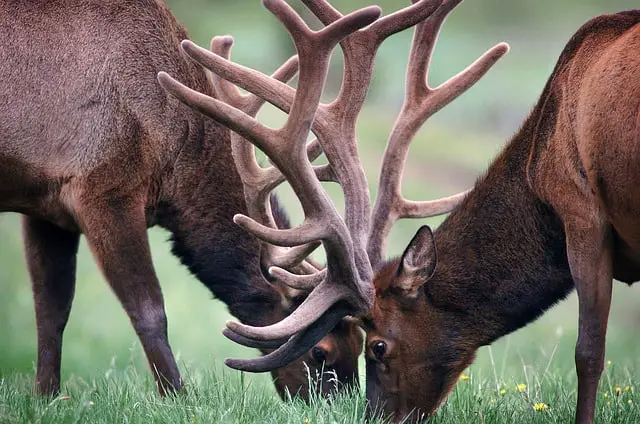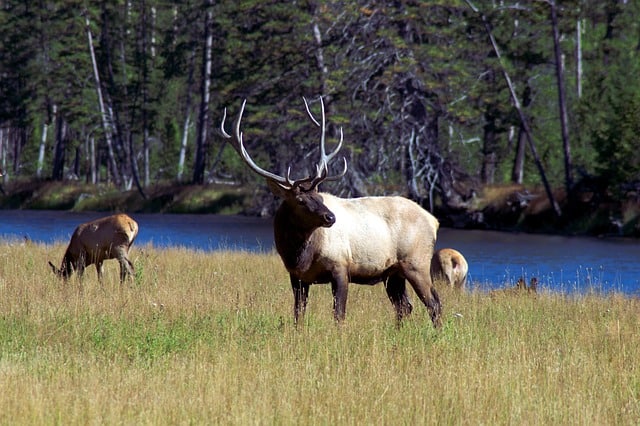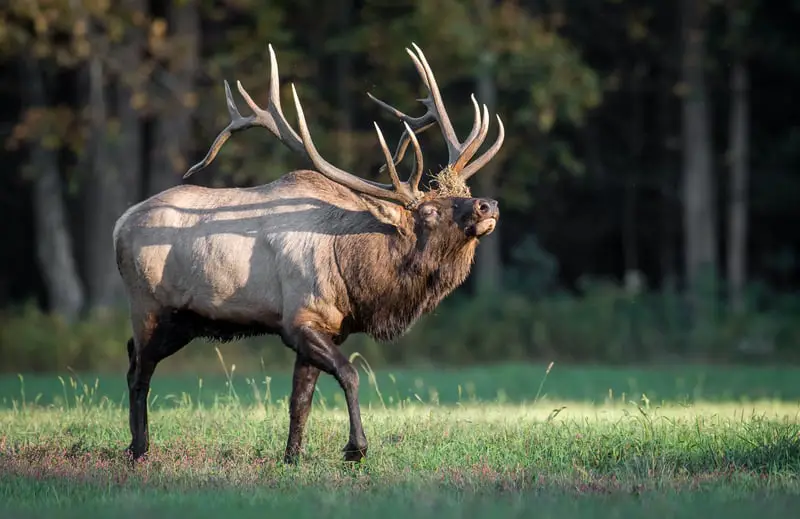After successful restoration efforts carried out by the Wisconsin Department of Natural Resources and some dedicated partners like the Rocky Mountain Elk Foundation and the Ho-Chunk nation, the state of Wisconsin has a statewide total population estimate of over 400 wild elk.
Prior to 1995, though, elk had been absent from Wisconsin for a very long time. Elk were once common over most of North America, including the Great Lakes region that now includes the state of Wisconsin. In fact, an analysis of state history and archeological discoveries indicate that elk probably once inhabited at least 50 of the 72 counties within Wisconsin. However, all that changed as European/American pioneers colonized the Wisconsin territory in the late 1700s and 1800s. Unregulated hunting and habitat loss both had devastating effects. Consequently, by the 1880s, there were no more elk left in the state of Wisconsin. See
Restoring elk in Wisconsin
The first restoration effort of elk in Wisconsin took place in 1913. The subspecies of elk native to Wisconsin and all of the eastern United States, “Eastern Elk,” were extinct. The Wisconsin Conservation Commission loaded a small number of “Rocky Mountain elk” from Yellowstone Park in Wyoming on a train box car and shipped them back to the Trout Lake area near Boulder Junction, Wisconsin. At Trout Lake, they placed them in a 300-acre fenced-off area. Unfortunately, these elk were so weak that only 2 cows survived the winter. Charles Comiskey, who owned the Chicago White Sox at the time, donated a bull to go with the 2 remaining cows.
In 1917, the WCC brought an additional 32 cows, and young bull elk to the Trout Lake preserve. These elk also struggled to survive. Over the next ten years, there were as many deaths as births within the herd. By 1928 the herd consisted of 17 cows, 19 bulls, and 9 calves.
In 1931, during the great depression, the WCC determined that it was too costly to maintain and protect the herd from poachers at Trout Lake. Consequently, they opened the gates and set the herd free to fend for itself. These elk eventually all succumbed to disease or poaching. A poacher killed the last known elk from the Trout Lake herd in 1943. See

Elk restoration efforts in more recent years
In 1989 the Wisconsin state legislature instructed the Wisconsin DNR to explore the feasibility of reintroducing elk, moose, and or caribou back into the state. The DNR study determined that a reintroduction of elk held the most promise of success and was determined to bring elk back into the state.
There is very little ideal elk habitat in Wisconsin’s southern counties. This is due to a high human population density and a high percentage of the land being converted over to agriculture. Most of the suitable habitat is located in northern and central Wisconsin.
Consequently, the WDNR chose first to bring elk back to northern Wisconsin.
In 1993, the Wisconsin state legislature sanctioned the University of Wisconsin-Stevens Point (UWSP) to research the ramifications of reintroducing elk to public lands in northern Wisconsin. They soon settled on territory in the Chequamegon-Nicolet National Forest near Clam Lake.
Elk from Michigan
In 1995, the first elk were reintroduced into Wisconsin. 25 of them had been trapped and held in quarantine in Michigan while they underwent disease testing. After that, they were brought to a holding facility near Clam Lake. After an acclimation period, they released the elk into the Chequamegon National Forest on May 17, 1995. For the first 4 years management of the experimental elk herd was the responsibility of a team of researchers from UWSP lead by the late dr. Ray Anderson. In 1999 the Wisconsin DNR staff took over management of the elk herd from the UWSP. See
At this time the clam lake elk herd population had expanded to 40 animals.
Today, the WDNR manages the northern elk herd with assistance from the U.S. Forest Service, and the Great Lakes Indian Fish and Wildlife Commission. The Rocky Mountain Elk Foundation and a large number of interested individuals, landowners, and volunteers also render assistance.
Elk from Kentucky
In 2014 the WDNR reached an agreement with the Kentucky Department of Fish & Wildlife Resources to acquire up to 150 elk from that state. The WDNR would assist the KDFWR with technical assistance and funding to improve ruffed grouse habitat in exchange for elk.
In 2015 and 2016, the WDNR released a total of 73 Kentucky elk into the Black River State Forest in the Black River Falls area. These 73 elk were the nuclease of the Black River herd. The Black River herd is the state’s central elk herd. It is located in west-central Wisconsin.
In 2017, the WDNR released 31 Kentucky elk into the Flambeau River State Forest near the town of Winter. The DNR released 48 more Kentucky elk into the FRSF in 2019. These releases augmented the Clam Lake herd.
Wisconsin’s elk range today and, in the future
Today, the Clam Lake elk range takes in 1,620 square miles in Ashland, Bayfield, Price, Rusk, and Sawyer counties in northern Wisconsin. On the other hand, the 252-square-mile black river elk range is in the forested region of Jackson County in the central part of the state.
The Wisconsin Division of Wildlife Resources foresees a time when the state’s total elk population will numberer close to 1800 animals. They have a long-term population goal of 1,400 elk in the northern zone and 390 in the central zone.
Elk in southern Wisconsin
The WDNR did not originally reintroduce elk into southern Wisconsin due to the scarcity of suitable habit. However as populations expand, some animals will travel large distances away from their intended home ranges.
A news release that the WDNR put out last year states that a bull elk was sighted in southeastern Wisconsin and southwestern Wisconsin for the first time in over 100 years.

Wisconsin elk hunting
The managed Wisconsin elk hunt in history took place in 2018. The state approved the hunt after the population of the northern herd in the clam lake area surpassed 200 animals. The hunt was confined to the Clam Lake elk herd in the northern elk management zone. The state has held a hunt there every year since then.
The harvest quota set for Wisconsin’s northern elk zone was 10 bull elk. Since the hunt took place in the ceded northern territory, 5 of the 10 tags were set aside for members of Wisconsin’s 6 Ojibwe tribes, per their treaty rights from 1837 band 1842.
“A little background on this is that in the treaties of 1837 and 1842, the Chippewa tribes ceded their land in northern Wisconsin, Michigan, and Minnesota to the federal government. ” Chippewa and Ojibwe are synonymous.” However, they retained off reservation hunting and fishing rights in what is now called the ceded territory. Their descendants still have those rights today. A 1983 federal court case commonly called the Voigt Decision affirmed that the Chippewa have rights to 50% of the harvestable resources in the Ceded Territory, which takes in approximately the northern 1/3 of the state of Wisconsin.”
The state awarded a total of 4 once-in-a-lifetime elk tags to Wisconsin state hunters through a random drawing. 38,400 applicants paid the $10.00 application fee. An additional elk tag was made available to a Wisconsin hunter through a raffle conducted by the Rocky Mountain Elk Foundation. One hundred percent of the proceeds from the 5000 raffle tickets that were sold went back into funding elk conservation and habitat restoration in the state of Wisconsin.
Since 2018 Wisconsin has held a bull elk hunt in the northern elk management zone in the same manner
Since the elk hunt began, state and tribal hunters have harvested 31 elk.
In 2022, the eight-elk quota will be split equally between Wisconsin’s Ojibwe tribes and state-licensed hunters, each receiving four tags. 2022 is the last year that a tag will be held in reserve for the RMEF raffle. In 2023 all of the state hunter’s tags will be awarded through a random drawing.
Contributors to Wisconsin elk reintroduction success
Some of the financial contributors to Wisconsin’s Rocky Mountain Elk Foundation, the Jackson County Wildlife Fund and the Ho Chunk Nation. Numerous individuals have volunteered their time to making the project a success. Here’s an example from 2017 when the WDWR enlisted the help of individuals to hunt for newborn elk calves so that they could place radio collars on them.
Threats to Wisconsin’s elk herds
According to Wisconsin Department of Natural Resources biologist, Laine Stowell, from 1995 through 2018, the WDNR recorded 262 elk mortalities. 42% of those deaths were wolf kills. Black bears killing elk calves accounted for 11% of the mortalities. After that, the third leading cause of elk deaths was vehicle collisions. See
Sometimes hunters illegally shoot elk during Wisconsin’s white-tailed deer season. 2021 marked the 4th year in a row in which at least one elk was illegally killed during deer season. See
When well-meaning individuals feed the elk, it also puts them in jeopardy. When numerous elk cross busy roads to get to a centralized feed source, it puts them in jeopardy. It also creates a disease risk to concentrate multiple wild animals on a small feed ground.
You might also like the following:
Wild Cats in Wisconsin – Krebs Creek
Venomous Snakes of Wisconsin – Krebs Creek
Are There Bears in Wisconsin? – Krebs Creek
Recent Posts
The only venomous snakes in Washington State are Northern Pacific Rattlesnakes. The Northern Pacific Rattlesnake (Crotalus oreganus oreganus) is a sub-species of the Western Rattlesnake. Anyone...
Skunks are not classified as true hibernators. But they go into a state of torpor when the weather gets cold. Skunks are light sleep hibernators, along with opossums, bears, and raccoons. ...

